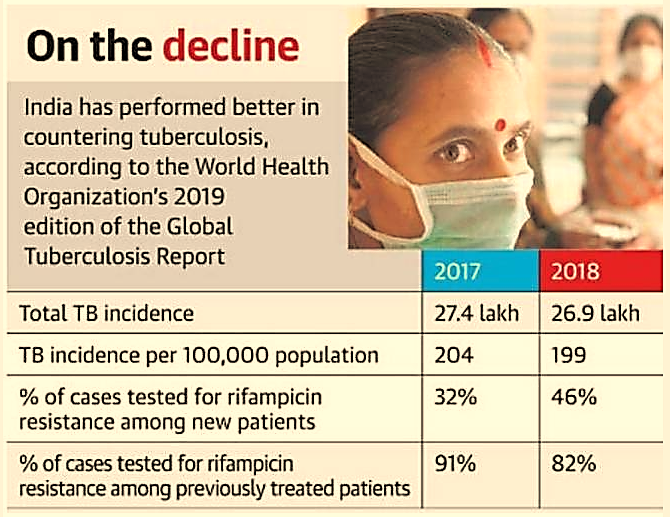Global Tuberculosis Report-2019
- 21 Oct 2019
- Recently, the World Health Organization (WHO) released the Global Tuberculosis (TB) Report, 2019.
- The report is based primarily on data gathered by WHO in annual rounds of data collection, and databases maintained by other multilateral agencies.
- WHO has published a global TB report every year since 1997.
Objective
- To provide a comprehensive and up-to-date assessment of the TB epidemic, and of progress in the response to the epidemic, at global, regional and country levels, in the context of global commitments and strategies.
Key Findings
India Specific findings
- 9 percent of the global TB burden of 10 million in 2018 was from India. In 2017, the figure was 27 percent.
- The total TB incidence rate in India has decreased by almost 50,000 patients over the past one year, even though it accounted for more than a quarter of the global burden of tuberculosis in 2018
- Incidence per 1 lakh population decreased from 204 in 2017 to 199 in 2018.
- The number of patients being diagnosed for resistance to rifampicin increased from 32 percent in 2017 to 46 percent in 2018 due to mandatory testing for resistance.

Source: The Hindu
Global Specific Findings
- Around 66 per cent of that burden came from eight countries: India (27%), China (9%), Indonesia (8%), the Philippines (6%), Pakistan (6%), Nigeria (4%), Bangladesh (4%), and South Africa (3%).
- Geographically, most TB cases in 2018 were in the WHO regions of South-East Asia (44%), Africa (24%) and the Western Pacific (18%), with smaller percentages in the Eastern Mediterranean (8%), the Americas (3%) and Europe (3%).
- Drug-resistant TB continues to be a public health threat. In 2018, there were about half a million new cases of rifampicin-resistant TB (of which 78% had multidrug-resistant TB).
Major Concerns
2020 End TB Strategy Still Far:
- Currently, the world as a whole, most WHO regions and many high TB burden countries are not on track to reach the 2020 milestones of the End TB Strategy. The cumulative reduction between 2015 and 2018 was only 6.3%, considerably short of the End TB Strategy milestone of a 20% reduction between 2015 and 2020.
Finance Issues:
- Financing for TB prevention, diagnosis and treatment Funding for the provision of TB prevention, diagnostic and treatment services has doubled since 2006 but still falls far short of what is needed.
- The amount in 2019 is US$ 3.3 billion less than the US$ 10.1 billion estimated to be required in the Stop TB Partnership’s Global Plan to End TB 2018–2022, and only just over half of the global target of at least US$ 13 billion per year by 2022 that was agreed at the UN high-level meeting on TB.
Discrepancy in TB Diagnosis:
- Despite increases in TB notifications, there is still a large gap between the number of new cases reported (7.0 million) and the estimated 10.0 million (range, 9.0– 11.1 million) incident cases in 2018.
- This gap is due to a combination of underreporting of detected cases and underdiagnosed (i.e. people with TB do not access health care or are not being diagnosed at right time).
|
Way Forward
- Achieving the global milestones and targets for reductions in TB cases and deaths set in the End TB Strategy and the Sustainable Development Goals (SDGs Target 3.8) requires provision of TB care and prevention within the broader context of Universal Health Coverage (UHC), multi-sectoral action to address the social and economic determinants and consequences of TB, and technological breakthroughs by 2025.
- The End TB Strategy milestones can only be achieved if TB diagnosis, treatment and prevention services are provided within the context of progress towards UHC, and if there is multisectoral action to address the broader determinants that influence TB epidemics and their socioeconomic impact.
- In coming years, annual financing for TB prevention and care and for TB research needs to approximately double, access to TB care and preventive treatment needs to expand, substantial costs faced by TB patients and their households must be mitigated.
- The best investment that countries can make to ensure faster progress towards ending TB is to ensure that TB services are designed and delivered as part of an overall commitment to universal health coverage, built on the foundation of strong primary health care.




